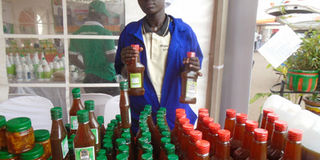How Lakoi makes honey sweeter for higher yields

Lakoi displays some of the honey products at her shop. Photo by Fred Muzaale
What you need to know:
Value addition is the surest way to improve the quality of the product, fetching more returns. Honey processing starts with uncapping, writes Fred Muzaale.
With the increasing demand of honey on the local market, many people are taking on beekeeping in the country.
However, despite many farmers taking on beekeeping, the amount of honey produced locally is not enough to meet the demand.
Local honey production is estimated to be between 8,000 and 10,000 metric tonnes per year.
This has forced traders of honey to look for the product from neighbouring countries such as Democratic Republic of Congo and South Sudan to meet the local market demand.
However, some people who sell honey sell it without adding value, thus, they earn little from it.
But Scovia Lakoi a resident of Mbuya in Nakawa Division in Kampala, who is one of the traders dealing in honey, has discovered the benefits of adding value to honey.
Lakoi, who is the production manager of Mapa Enterprises Ltd, says they buy unprocessed honey from the Democratic Republic of Congo. They buy a 20-liter jerry can of unprocessed honey at Shs240,000.
Process
The unprocessed honey (honey with honey combs) is taken to the factory where it is sieved to get out honey.The honey is sieved to remove the combs and debris.
The honey is then put in a container and left to settle for a day after which it is packed.
Lakoi says from the 20 unprocessed litres of honey they get on average between 15 and 17 litres of processed honey.
Cost of the product
Lakoi says a 700 grammes pack goes for Shs15,000, one litre at Shs20,000, 500 grammes at Shs10,000 while a 200 grammes pack goes for Shs5,000.
Lakoi says from a jerrycan they buy at Shs240,000 they can get about Shs480,000 and when they remove all the costs they can make a profit of about Shs160,000 per 20-litre jerrycan. In a week they sell about 100 litres of honey.
Market
Lakoi says they sell most of their products in supermarkets all over the country although they sometimes sell their products to retail shops.
Challenges
She says the biggest challenge they face now is lack of machinery used in sieving and packaging the honey.
This, she says, makes the work slower. However, they plan to buy machinery in the future.
Also, the high transport cost to DR Congo where they buy the honey reduces their profit margin. Since they do not have their own means of transport, they use public means which makes them take long to reach the factory to process the honey.
Uses of processed honey
Honey can be used as a sugar substitute in almost any recipe. When substituting most or all of the sugar with honey, mild flavoured honeys may be more desirable as they will not overpower other flavours of the product. Honey can be consumed or used in raw state as produced by the bees. Sweetness, nutritive value and functional advantages like viscosity, flavour enhancement, colour, hygro-scopicity, miscibility and spread ability makes honey a valuable food ingredient.
For baked products
Honey offers several advantages such as uniform baking with more evenly browned crust at lower temperatures, improved aroma by relatively small percentages of honey in sweet cakes, biscuits and bread, spongy consistency which persists longer, and softness.
Products that contain honey also dry out more slowly and have a lesser tendency to crack.
Honey in milk
Products include honey cream, honey cream cheese and honey butter. In the industrial sector, some non-medicinal honey-milk products exist, such as pasteurised and homogenised milk sweetened with honey for long-term storage.
For the production of caramels, honey is used only in very small quantities and in few products that include honey gums, nougat and torrone, caramels and candies.
Breakfast cereals industry: Honey is used either in its liquid or in its dried and pulverised form.
It can be mixed or applied as a component of the sweeting and flavouring film, which covers the flakes.
Sun dried fruits and nuts can be placed directly into the honey, either whole or chopped. Pasteurisation of both honey and fruits improves the hygiene and storability and reduces the risk of fermentation.
A variety of spreads for bread are available in the market.
There are products in which honey is either the major ingredient, such as flavoured honeys, or in which it only substitutes sugar as a cream spreads and fruit preserves. Fruit marmalade uses less sugar than other traditional recipes.
Honey in non-alcoholic drinks
Honey drinks are most frequently mixed with lemon juice for a pleasant sweet and sour taste. In many fruit juices too, honey is added for flavour and as a sweetener. In apple juice, it is used to clarify the fresh juice. This is where it is used to remove pectin and other carbohydrates which are present in the juice.
Fermented products
It is used in making alcoholic drinks that include honey beer, mead and wines.
Benefits of honey
Weight Management
Did you know you can use honey for weight management? According to the famous author and nutritionist Mike McInnes, honey burns body fat even while when you are sleeping. It is one of the best foods for losing weight.
Immune system
Honey has countless medicinal properties that naturally help in curing a sore throat. Its antioxidants and bacteria-fighting assets also help against fighting infections that are caused by viruses, bacteria and fungi.
Nourishes your skin and face
Using honey for skin is very useful because of its moisturizing and nourishing properties. Honey is the best natural moisturizer, especially for your dry skin and it is also very easy to apply.
Additional in: Daily Nation




